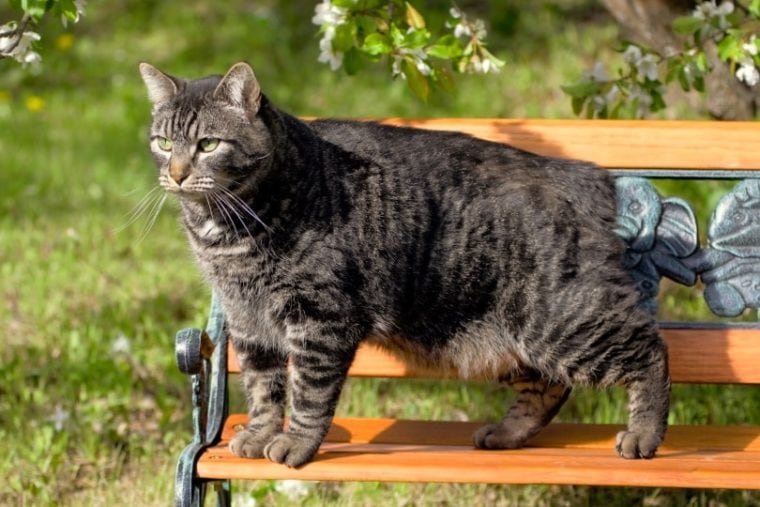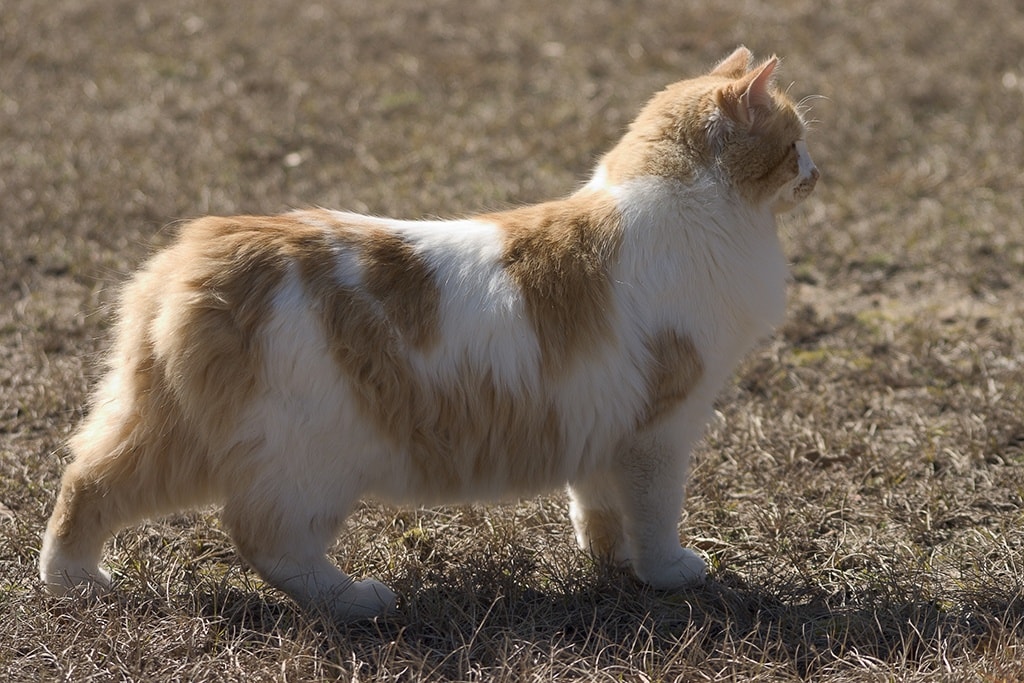
The Manx cat originated from a tiny island between Great Britain and Ireland, the Isle of Man, and it’s also home to several legends involving the Manx’s development. Some believed that the cat was a hybrid mix of a feline and rabbit, and others suggest the cat was late entering Noah’s Ark and got its tail caught in the door. The short-tailed cat, or no-tailed in some cases, is a muscular animal, skilled in hunting rodents and fond of interacting with humans. They make exceptional pets that can live long, healthy lives, but susceptible to severe medical issues.

The M Mutation
If you’re planning to adopt a Manx, it’s critical to inspect the breeder’s operation and ensure that Manx kittens are cleared of any genetic disease. However, all Manx are vulnerable to conditions related to the M-mutation. The cats are heterozygous for the mutation that makes them tailless, and when two heterozygous parents produce a homozygous kitten, it usually dies in the uterus before birth. Manx can have four types of tails:
Rumpy Manx and rumpy risers are prone to medical conditions affecting the spine.

The 10 Most Common Manx Cat Health Problems
1. Manx Syndrome
Manx syndrome is a crippling condition that affects approximately 16% of Manx kittens. Tailless and rumpy-tailed cats are more vulnerable to spinal issues related to Manx syndrome than long-tailed cats. The disease covers several spinal problems, but the most prevalent form is spina bifida. It occurs when the spine’s bones do not develop completely and the neural tube forming the spinal cord does not close.
Signs of the condition include an abnormal gait, hind leg dragging, fecal or urinary incontinence, and loss of feeling in the hind legs. There is no cure for spina bifida, although surgery may improve mobility in some cases. Cats with Manx syndrome must be handled carefully to prevent further injuries, and owners have to modify their homes to accommodate Manx who cannot move like healthy cats.

2. Fecal Incontinence
Bowel incontinence can occur with other cat breeds, but one form of the condition is more common in Manx cats. Reservoir incontinence is a rectal disease that prevents cats from storing feces properly, and sphincter incontinence occurs when the anal sphincter cannot remain closed. Sphincter incontinence can be caused by anal lesions or damage to the nerves connected to the spinal cord, which is more common in Manx cats.
Signs of sphincter disease include inflammation of the rectum, redness, rectum draining, and licking the rectum. Treating sphincter issues is more challenging for vets than reservoir problems, but surgery can improve some conditions. However, some cats with fecal incontinence cannot be treated, and most live with the problem for the rest of their lives.
3. Megacolon
A megacolon diagnosis is more common in cats than dogs, and it occurs when the colon is stretched out and weakened. Initial signs of the condition may include fewer bowel movements, painful constipation, and abnormally hard feces, but the disease can progress and lead to appetite loss, vomiting, dehydration, weight loss, and less energy.
Megacolons can result from nerve damage in the colon or constipation. When the condition is discovered early, the treatments are more successful. However, megacolon is a fatal disease when left untreated. Cats may be given laxatives, enemas, or high-fiber diets to relieve symptoms, but severe cases may require surgery to remove part of the colon.

4. Constipation
Constipation is a treatable condition, but failure to address the problem can cause megacolon. Constipation has several causes that include intestinal obstruction, litter box issues, underlying disease, and dehydration. After a physical exam, a veterinarian may use X-rays to examine the extent of the condition and blood tests to rule out severe disease.
Medications and diet changes can relieve constipation, but some cats may need to continue the treatment indefinitely to prevent future occurrences. Healthy cats typically have one bowel movement per day, but cats that do not defecate for 48 hours should be taken to the doctor immediately.
5. Corneal Dystrophy
Most breeds are not vulnerable to corneal dystrophy, but Manx and Domestic Shorthairs are predisposed to the condition. Corneal dystrophy is an inherited condition that typically affects both eyes, and treatment is critical since it’s a progressive disease. The disease is categorized into three types, but Manx are more vulnerable to the endothelial form of corneal dystrophy.
Endothelial dystrophy often affects younger cats and can cause fluid blisters to form on the cornea and vision impairment. Veterinarians can remove corneal tags to treat endothelial cases, and some cats receive contact lenses to improve their vision.

6. FLUTD
Feline lower urinary tract disease (FLUTD) is a general term for conditions that affect the bladder and urethra. Although FLUTD can occur at any point in a cat’s life, the animals that are more vulnerable to the disease include indoor cats who rarely exercise, felines on dry food diets, and overweight cats. Signs include crying while urinating, bloody urine, excessive genital licking, peeing outside the litter box, and straining to urinate.
FLUTD has several causes, including urinary stones and obstructions, but Manx are vulnerable to getting the condition from spinal cord abnormalities. Veterinarians will determine the cause of the disease before treatment, and an early diagnosis can prevent the issue from developing into a life-threatening illness.
7. Diabetes
In some cases, diabetes does not significantly shorten a cat’s life when treated appropriately by the owner. Diabetes can be caused by feeding cats human food too frequently, obesity, and steroid use. Although diabetes is a severe disease that can be fatal, most animals may improve with daily insulin injections and diet changes.
Some cats will need insulin shots for the rest of their lives, but others with less severe cases may only need them temporarily. Maintaining a high-protein and low-carb diet can help felines manage the disease.

8. Mast Cell Tumors
Internal organs or the skin may be affected. The cancer appears as small lumps or flattened areas on the skin, and the most common locations are the top of the head and ears. Pets with the intestinal form of the disease may experience vomiting, diarrhea, blood in the stool, and tar black-colored stools.
Splenic cases can have weight loss, appetite loss, and vomiting. Veterinarians can remove the cancerous lumps, but radiation therapy or chemotherapy may be necessary in severe cases. Diagnosing the condition in the early stages is critical because the cancer can spread to the lymph nodes, liver, lungs, or bone marrow.
9. Obesity
Overweight cats may be amusing to non-cat lovers, but obesity is a serious issue that can lead to other conditions like arthritis, cardiovascular disease, and metabolic disorders. Unfortunately, Manx are vulnerable to obesity, and up to 63% of cats in developed countries are obese. Obesity restricts mobility and makes it more difficult for cats to leap and climb stairs.
Veterinarians can help pet parents treat their obese felines by setting daily calorie goals to aid weight loss and prescribing special diets that help the body burn more fat for energy than glucose. Obesity is treatable, but it’s also a preventable condition that can be avoided with a healthy diet, exercise, and veterinary care.

10. Fatty Liver Syndrome
Fatty liver syndrome, also called hepatic lipidosis, is the most common type of liver disease in cats. When felines are starved or malnourished, their bodies will transfer fat to the liver. The liver cannot process large volumes of fat, and it can become swollen and turn yellow. When the pigment is released into the cat’s blood, its eyes can also turn yellow.
The condition is treatable if caught early, but when left untreated, it can be deadly. Signs of the disease include diarrhea, rapid weight loss, vomiting, constipation, jaundice, depression, drooling, and muscle loss. Veterinarians must treat severe cases with fluid therapy and medications that require hospitalization, but early stages are often treated with special diets to introduce more protein.

Conclusion
Manx cats are vulnerable to several medical conditions, but they’re active, friendly pets that can live long lives with the proper care. If you have a Manx without a tail, you’ll need periodic veterinary examinations to ensure the cat is not suffering from Manx syndrome. Owning a Manx can be an incredible experience, but you have to monitor its health closely to ensure it does not suffer from a spinal condition.
Featured Image Credit: rokopix, Shutterstock






